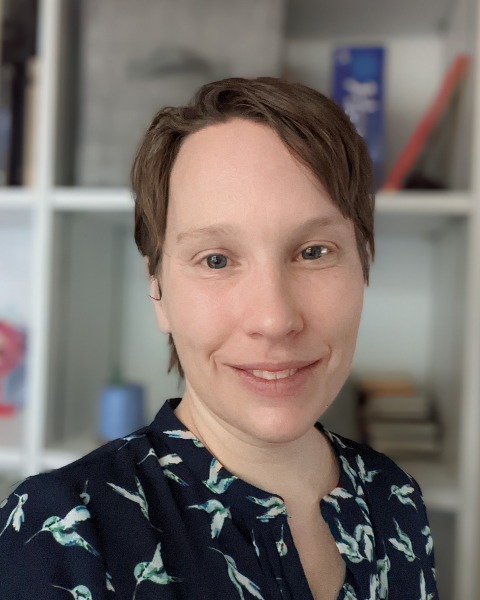Medical Education: Resident
Category: Abstract Submission
Medical Education 15 - Medical Education: Resident VI
297 - Trainee Involvement in Bedside Invasive Procedures—Time for a Paradigm Shift
Monday, April 25, 2022
3:30 PM - 6:00 PM US MT
Poster Number: 297
Publication Number: 297.421
Publication Number: 297.421
Mara Alexeev, Boston Children's Hospital, Brookline, MA, United States; Frank Gonzalez, Children's Hospital Los Angeles, Los Angeles, CA, United States; Amir Kimia, Boston Children's Hospital, Boston, MA, United States; Assaf Landschaft, Boston Children's Hospital, Bergisch Gladbach, Nordrhein-Westfalen, Germany; Joshua Nagler, Boston Children's Hospital Division of Emergency Medicine, Brookline, MA, United States; Jonathan Hron, Boston Children's Hospital, Boston, MA, United States

Mara Alexeev, MD, MPH
Clinical Informatics Fellow
Boston Children's Hospital
Brookline, Massachusetts, United States
Presenting Author(s)
Background: Involvement in invasive bedside procedures is a requirement for Pediatric [PEDS], Pediatric Emergency Medicine [PEM], and Emergency Medicine [EM] trainees during Pediatric Emergency Department [PED] rotations.
Objective: Quantify the number of invasive bedside procedures trainees attempt.
Design/Methods: Retrospective chart review of providers performing lumbar puncture [LP] and skin abscess incision and drainage [I&D] at a tertiary PED between 2017-2019, excluding consultant procedures. We included all patients evaluated in our ED, and all ED providers during the study period. We only included trainees that completed either a 2- or 4-week rotation. As unsuccessful procedure attempts may not be captured by billing or structured data, we created a natural language processing [NLP] model to capture all attempts. We calculated prevalence with Bayesian credible intervals.
Results: We identified 1,113 LP and 798 I&D attempts during the study period. There were 928 resident rotations through the ED; 552 (59%) were PEDS residents, 359 (39%) EM trainees, and 17 (1.8%) visiting residents, in addition to 18 PEM fellows working in the ED each year.
An LP was attempted by a PEDS resident in 310 (28%) of the cases, an EM resident in 174 (16%), a PEM fellow 267 (24%) and PEM attending 256 (23%).
Calculating resident LP attempts per rotations resulted in a range of 0-5, with a median of 0.33 [IQR 0-1]. During the study period, 199 residents (43%) did not perform an LP during, while 126 residents (27%) performed a range of 2-15 LPs.
For PEM fellows the average was 5 LPs throughout the entire 3-year fellowship and for PEM attendings it translates to under 1 LP a year.
An I&D was attempted by a PEDS resident in 176 (22%) of the cases, an EM resident in 152 (19%), a PEM fellow in 176 (22%), and a PEM attending 263 (33%).
Calculating Residents I&Ds attempts per rotation resulted in a range of 0-3 with a median of 0 (IQR 0-0.75). During the study period, 281 residents (60%) did not perform an abscess I&D during their rotations, while 64 residents (14%) performed a range of 2-8 I&Ds.
For PEM fellows it was an average of 9 I&Ds throughout the entire 3-year fellowship and for PEM attendings it translates to 1-2 I&D a year.
Patients seen by an attending with no trainee involvement were more likely to have the procedures done by an attending.Conclusion(s): The current bedside procedure involvement in our ED is minimal and unevenly distributed. If residents perform these procedures on other rotations in similar or smaller numbers, mitigation strategies should be considered such as expectation adjustments and simulation.
Objective: Quantify the number of invasive bedside procedures trainees attempt.
Design/Methods: Retrospective chart review of providers performing lumbar puncture [LP] and skin abscess incision and drainage [I&D] at a tertiary PED between 2017-2019, excluding consultant procedures. We included all patients evaluated in our ED, and all ED providers during the study period. We only included trainees that completed either a 2- or 4-week rotation. As unsuccessful procedure attempts may not be captured by billing or structured data, we created a natural language processing [NLP] model to capture all attempts. We calculated prevalence with Bayesian credible intervals.
Results: We identified 1,113 LP and 798 I&D attempts during the study period. There were 928 resident rotations through the ED; 552 (59%) were PEDS residents, 359 (39%) EM trainees, and 17 (1.8%) visiting residents, in addition to 18 PEM fellows working in the ED each year.
An LP was attempted by a PEDS resident in 310 (28%) of the cases, an EM resident in 174 (16%), a PEM fellow 267 (24%) and PEM attending 256 (23%).
Calculating resident LP attempts per rotations resulted in a range of 0-5, with a median of 0.33 [IQR 0-1]. During the study period, 199 residents (43%) did not perform an LP during, while 126 residents (27%) performed a range of 2-15 LPs.
For PEM fellows the average was 5 LPs throughout the entire 3-year fellowship and for PEM attendings it translates to under 1 LP a year.
An I&D was attempted by a PEDS resident in 176 (22%) of the cases, an EM resident in 152 (19%), a PEM fellow in 176 (22%), and a PEM attending 263 (33%).
Calculating Residents I&Ds attempts per rotation resulted in a range of 0-3 with a median of 0 (IQR 0-0.75). During the study period, 281 residents (60%) did not perform an abscess I&D during their rotations, while 64 residents (14%) performed a range of 2-8 I&Ds.
For PEM fellows it was an average of 9 I&Ds throughout the entire 3-year fellowship and for PEM attendings it translates to 1-2 I&D a year.
Patients seen by an attending with no trainee involvement were more likely to have the procedures done by an attending.Conclusion(s): The current bedside procedure involvement in our ED is minimal and unevenly distributed. If residents perform these procedures on other rotations in similar or smaller numbers, mitigation strategies should be considered such as expectation adjustments and simulation.
